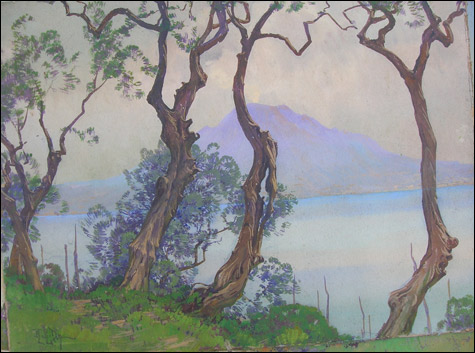
CALLIGRAPHIC LINES: Dyer's Sorrento Coast, Italy. |
Back in 1928, a Providence Journal headline dubbed painter Hezekiah Anthony Dyer a "militant anti-Modernist." Modern art was just about showing off, he said. It was fueled by the usual fad for whatever's new — and the money that can be made off it. He was a traditionalist. He wasn't impressed.
Dyer's thing was watercolors and gouaches of romantic fairy tale country cottages, snowy mountain lakes, and ruins of old stone arches and doorways, as demonstrated by 25 of his works in the exhibit "Old World Charm: Watercolors by H.A. Dyer" at Bert Gallery (540 South Water Street, Providence, through March 6).
You can understand why tradition would be his thing. Dyer (1872-1943) was born in Providence. His dad and granddad were Rhode Island governors. He studied at Brown and RISD and spent part of most of his years in Europe (Belgium, France, England, Switzerland, Italy) painting realist landscapes. He was president of the Providence Art Club from 1905 to 1914 and then president of the Republican Club of Rhode Island from 1916 to 1919.
The paintings here are mostly small, charming renderings on paper of Old World locales (they look Old World even when he's painting New England). And he could afford to go to some of the most picturesque spots. His sepia-hued cottages and crooked streets recall children's books and Disney's early films.
But the majority of his paintings here are brightly hued. A purple cottage with green roof stands stoutly in a shaggy grassy yard in Barbizon, France. The branches of trees in front of the house appear like red veins against a pale blue sky. Dyer applies the colors softly and fluidly.
Some of his paintings are mushy muddles, like a rendering of trees along a shaggy Nayatt shore in Barrington, Rhode Island. And he can get pasty and dull, as in his painting of an old, overgrown stone arch overlooking blue sea. Mount Vesuvius, in the background, exhales a white plume of smoke.
But often Dyer is crisp, as in his painting of a series of overlapping mountain ridges in Jungfrau, Switzerland. A splash of green trees stands in the foreground, followed by purple mountains rising to snowy white peaks stark against blue sky. These scenes get their snap from their limited colors — frosty white, sweet blues, purples, and greens (the same catchy color combo that helped make the Incredible Hulk so exciting) — painted in flat layered patches. It's a technique that may be of particular interest to screenprinters. They radiate the freshness and crackle and heartaching dream of travel posters.
The works are undated, but it's tempting to separate them into before (browns) and after (bright colors). Dyer was born at the end of last great era of European realism, just as Impressionism was sprouting. His work bears hints of an Asian influence in the calligraphic lines of knotty trees in a painting of the coast of Sorrento, Italy. And one might guess that he adopted American Impressionist style — which used the bright, pretty colors and soft tones of French Impressionism but was often more traditional than the French in its painterly technique. But it's unclear here just how his career progressed.
Read Greg Cook's blog at gregcookland.com/journal.